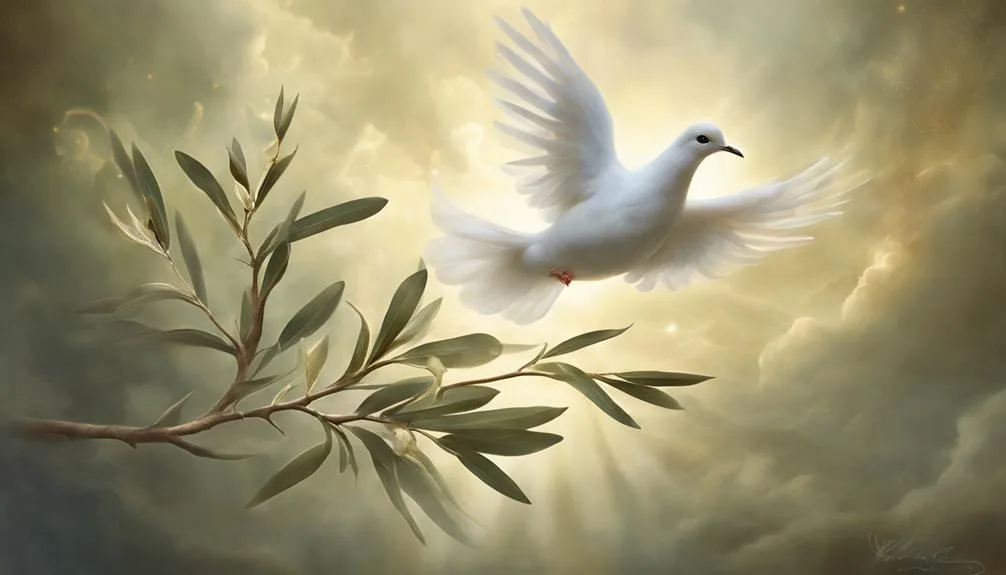The olive branch is a strong symbol of peace and hope in the Bible. It appears in stories like Noah's Ark and is often seen in Christian art, representing reconciliation and peace.
This symbol has a rich history and carries deep meanings about peace and healing in difficult times. Let's explore the significance of the olive branch in biblical stories and what it tells us about its lasting symbol of peace.
Key Takeaways
- Olive branch signifies peace, reconciliation, and divine grace in biblical context.
- Symbolizes hope, renewal, and restoration of relationships.
- Represents prosperity, abundance, and the end of turmoil.
- Conveys harmony, forgiveness, and unity as a tangible sign of goodwill.
Symbolism in Biblical Context
In the Bible, the olive branch carries powerful symbolism, representing peace, reconciliation, and divine grace. This symbolic imagery dates back to ancient times and holds significant historical significance within biblical contexts. The olive tree itself is a symbol of prosperity and abundance in the Bible, often associated with blessings from God. When the olive branch is mentioned, it conveys a message of hope and renewal, emphasizing the restoration of relationships and the end of conflicts.
Historically, the olive branch was used as a sign of peace by various cultures and civilizations. In the Bible, the olive branch first appears in the story of Noah and the Great Flood. After the floodwaters receded, Noah sent out a dove, which returned with an olive branch in its beak, signaling the end of God's wrath and the beginning of a new era. This event established the olive branch as a universal symbol of peace and reconciliation, demonstrating God's grace and mercy towards humanity.
Sign of Peace and Reconciliation
Symbolizing the essence of harmony and forgiveness, the olive branch holds a profound significance as a beacon of peace and reconciliation in biblical teachings. In the Bible, extending an olive branch isn't merely a symbolic gesture but a tangible act reflecting the desire for peace and reconciliation. The olive branch is a powerful visual representation of extending goodwill and seeking resolution in times of conflict or discord. It serves as a peaceful gesture, conveying the message of forgiveness and unity, echoing the biblical teachings of love, compassion, and understanding.
The biblical significance of the olive branch as a sign of peace and reconciliation can be traced back to its roots in the Old Testament. Stories like the reconciliation between Jacob and his brother Esau or the covenant of peace after the Great Flood with Noah releasing a dove carrying an olive branch highlight the enduring symbolism of the olive branch in biblical narratives. These narratives emphasize the importance of extending forgiveness and seeking reconciliation as fundamental principles in fostering harmonious relationships, reflecting the divine call for unity and understanding among humankind.
Connection to Noah's Ark

The connection to Noah's Ark through the olive branch symbolizes a profound message of hope and renewal in the biblical narrative. After the Great Flood, Noah released a dove which returned carrying an olive leaf, indicating that the waters had receded and new life was possible. This symbolic imagery of the olive branch has deep biblical significance, representing peace, restoration, and God's covenant with humanity. The olive branch serves as a powerful symbol of hope and renewal, signifying the end of a tumultuous period and the beginning of a new chapter.
To further understand the significance of the olive branch in relation to Noah's Ark, let's delve into a table that highlights its symbolic meanings:
| Symbolic Meaning | Interpretation | Biblical Reference |
|---|---|---|
| Olive Branch | Peace and Reconciliation | Genesis 8:11 |
| Dove | Messenger of Hope | Genesis 8:8-12 |
| Floodwaters | Cleansing and Renewal | Genesis 7:17-24 |
This table underscores the rich symbolism intertwined with the olive branch in the story of Noah's Ark, emphasizing themes of peace, hope, and divine renewal.
Representations in Christian Art
When exploring representations in Christian art, one can observe how the olive branch is often depicted as a powerful symbol of peace and divine renewal. Artists throughout history have utilized the olive branch in various ways to convey deeper meanings within their works. Here are three ways the olive branch is symbolically portrayed in Christian art:
- Peace: In Christian art, the olive branch is frequently used to symbolize peace, harkening back to the biblical narrative of Noah and the dove bringing an olive branch after the great flood. This symbolizes the peace and reconciliation between God and humanity.
- Renewal: The olive branch is also often associated with renewal and new beginnings. Its presence in Christian art signifies the hope and restoration found in God's grace and mercy.
- Eternal Life: Some artistic interpretations depict the olive branch as a representation of eternal life, connecting it to themes of salvation and everlasting peace in the Christian faith. The branch's evergreen nature symbolizes the eternal nature of God's love and promises.
Spiritual Meaning in Scriptures

In exploring the spiritual significance of the olive branch in Scriptures, one can uncover profound layers of meaning that resonate deeply within Christian theology and symbolism. The olive branch holds great symbolic significance in biblical interpretation, representing peace, reconciliation, and divine favor. This symbolism is rooted in various passages throughout the Bible, where the olive branch is used to convey messages of hope and restoration.
| Symbolic Significance | Biblical Interpretation |
|---|---|
| Peace | Genesis 8:11 |
| Reconciliation | Romans 5:10 |
| Divine Favor | Psalm 128:3 |
| Hope | Jeremiah 11:16 |
| Restoration | Romans 11:17 |
The olive branch's presence in these verses serves as a powerful metaphor for the relationship between humanity and God, emphasizing themes of forgiveness, grace, and renewal. Through biblical interpretation, the olive branch becomes a tangible symbol of God's enduring love and the promise of salvation for all who seek it.
Conclusion
The olive branch, deeply rooted in biblical symbolism, stands as a beacon of peace, reconciliation, and divine favor. Its storied connection to Noah's Ark underlines its significance as a symbol of hope and renewal.
As it weaves through Christian art and scripture, the olive branch embodies harmony and grace within the Christian faith, reminding believers of the Bible's core teachings on peace and unity.
How might this enduring symbol inspire us to reflect on our own pursuits of peace in today's world?

